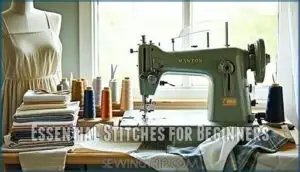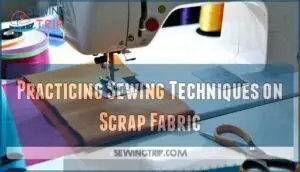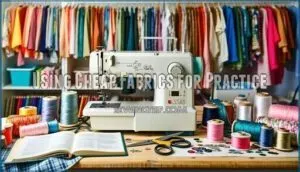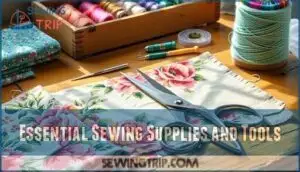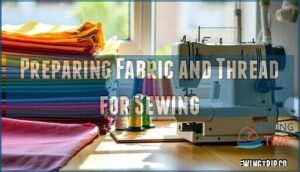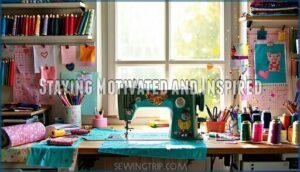This site is supported by our readers. We may earn a commission, at no cost to you, if you purchase through links.
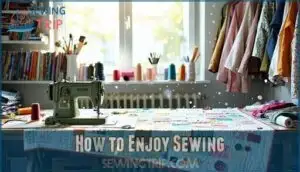 To enjoy sewing, start with simple projects that spark joy rather than tackling complicated patterns right away.
To enjoy sewing, start with simple projects that spark joy rather than tackling complicated patterns right away.
You’ll find your rhythm faster when you’re not fighting with fabric. Create a comfortable workspace with good lighting and all your tools within reach – nothing kills creativity like hunting for scissors mid-project!
Don’t sweat the small mistakes; they’re part of your sewing story. Join online communities where you can share triumphs and laugh about those backward sleeves we’ve all sewn.
Remember to take breaks when frustration builds. The journey of creating something with your own hands offers rewards beyond the finished product.
Table Of Contents
Key Takeaways
- Let go of perfectionism and embrace mistakes as part of your sewing journey—they’re learning opportunities, not failures, and will help you maintain a positive mindset.
- Create a comfortable workspace with good lighting and keep all your tools within reach to avoid frustration and make sewing more enjoyable.
- Start with simple projects and inexpensive fabrics to build your confidence without pressure, focusing on the process rather than perfect results.
- Take breaks when frustration builds, practice self-compassion, and remember that sewing should spark joy—it’s about creative fulfillment, not stress.
Enjoy Sewing Basics
Starting with the basics makes sewing feel less overwhelming and way more enjoyable.
Focus on your mindset, embrace mistakes as part of learning, and let go of the pressure to make everything perfect.
Mindset and Emotional Well-being
Your mindset shapes your sewing experience.
Stress often sneaks in, but it’s rarely the project—it’s your perspective.
Recognize perfectionism pitfalls and embrace sewing self-compassion.
Accepting mistakes fuels creativity and fun, not frustration.
Pause, name your stress, and reset with a positive mindset.
Sewing should spark joy, not dread.
Remember, it’s about progress, not perfection!
Importance of Compassion and Self-Forgiveness
Forgiving yourself when stitches go wonky or seams don’t align perfectly is part of the process.
Mistakes aren’t failures—they’re lessons in disguise. Practice positive self-talk and remind yourself that sewing self-compassion leads to growth.
Perfectionism steals joy, but self-forgiveness benefits your creativity. Embrace mistakes as learning opportunities, and you’ll reduce sewing anxiety while nurturing a healthier sewing mindset.
Avoiding Perfectionism in Sewing
Let go of sewing perfectionism—it’s a creativity thief.
Embrace imperfection like a quirky friend; it keeps things interesting.
Mistakes aren’t failures; they’re lessons in disguise.
Set realistic expectations, and remember, no one’s grading your seams.
Enjoy the process, laugh at wonky stitches, and practice self-compassion.
Understanding the importance of choosing the right needles can also improve your sewing experience.
A relaxed mindset turns sewing into joy, not a chore.
How to Enjoy Sewing

Sewing is more enjoyable when you let go of perfectionism and embrace the process with a positive mindset.
Think of it as a mix of precision and play—like baking cookies but with less mess and no burnt edges!
Approaching Sewing With a Positive Mindset
Sewing’s supposed to be fun, not a stress marathon!
Recognize when perfectionism sneaks in and adjust your mindset.
Accepting mistakes isn’t failure—it’s learning. Set realistic expectations, and don’t let deadlines steal your joy.
Self-compassion is your best tool; treat yourself kindly. A relaxed mindset turns sewing into a playground for creativity, sparking more joy and satisfaction.
Balancing Precision and Experimentation
Think of sewing like cooking and baking combined—some parts need precision, like following a pattern, while others invite improvisational techniques and design freedom.
This balance sparks sewing creativity and keeps projects fun, as it allows for a mix of structure and intuitive sewing by experimenting with pattern hacking or adding personal touches.
Remember, a little sewing improvisation can turn “oops” moments into sewing enjoyment and relaxation.
Understanding Project Types for Enhanced Enjoyment
If precision feels stiff, think of sewing like cooking vs. baking.
Some sewing projects demand exactness, like baking a cake, while others invite project experimentation, stirring creativity like cooking a stew.
Recognizing the type enjoyment each project offers keeps sewing fun, balancing precision and experimentation energizes sewing hobbies, turning challenges into sewing satisfaction.
It’s all about finding joy in your sewing rhythm.
Mastering Sewing Techniques
You’ll enjoy sewing so much more when you master a few essential techniques, like stitching evenly and finishing seams neatly.
Start simple, practice often, and don’t stress—every crooked stitch is just part of the learning curve!
You will be rewarded if you solve the task correctly.
Essential Stitches for Beginners
Starting with sewing basics is easier than you’d expect! The Running Stitch is the perfect first step—simple and strong, like peanut butter on toast.
Next, try the Basting Stitch for temporary holds or the durable Backstitch for lasting seams. Add finesse with the invisible Slipstitch or decorative Blanket Stitch.
Explore a running stitch tutorial for more in-depth guidance. These sewing stitches build your skills beautifully.
Practicing Sewing Techniques on Scrap Fabric
Grab some scrap fabric and let loose! Practicing sewing techniques here lets you experiment freely and improve your sewing skills without worry.
Watch your stitch practice come alive as seams become crisp and neat. Explore various home decor projects using your growing collection of scraps.
For better seam visibility and skill improvement, try this:
- Use contrasting thread.
- Practice straight stitches.
- Master curves.
- Test decorative stitches. This will help you improve your overall sewing techniques.
Using Cheap Fabrics for Practice
Practicing with scrap fabric is smart, but cheap fabrics are your best friend for sewing practice too.
Head to thrift stores or clearance aisles for budget-friendly finds.
Mistake acceptance feels easier when fabric costs less, letting you experiment freely, it saves money, builds skills, and reduces stress—because who worries about perfection with a dollar’s worth of fabric?
Setting Up Sewing Space
Creating a cozy, organized sewing space can make all the difference in enjoying your projects.
Keep your tools handy, your chair comfy, and don’t let fabric scraps take over—unless they’re auditioning for their next big role, which can be a cozy and organized way to approach your sewing space.
Essential Sewing Supplies and Tools
Before stitching away, stack your sewing kit with fabric scissors, cutting tools, marking tools, and a variety of needle types.
Keep sewing supplies handy—pins, a pincushion, and sturdy thread. Sewing notions like a seam ripper and a tape measure are lifesavers.
Consider specialized cutting tools for different fabrics. Don’t ignore workspace ergonomics—chair comfort matters!
Plus, a clean machine is pure magic; machine maintenance stops hiccups.
Allocating Dedicated Time for Workspace Setup
With a well-planned sewing workspace, you’ll thank yourself later.
Think ergonomics—adjust your chair and table heights to avoid aches.
Arrange tools smartly for a breeze during projects.
Lighting is essential—natural light or a focused lamp saves your eyes.
Use storage solutions to reduce clutter; everything should feel handy yet elegant.
It’s all about creating an inviting sewing environment!
Preparing Fabric and Thread for Sewing
Before diving into the sewing process, give your fabric some love with proper pre-treatment—wash, dry, and press it to avoid unexpected shrinkage.
For thread selection, match thread type and color to your fabric.
To prevent damage, consider using microtex needles for delicate materials.
Master threading your sewing machine, wind the bobbin tightly, and adjust tension if needed. These small sewing preparation steps make sewing easier and frustration-free!
Staying Motivated and Inspired
Staying motivated while sewing is easier when you fill your projects with fun and purpose.
Whether it’s mixing in lighthearted projects or exploring vintage techniques, keeping things fresh helps spark your creativity and passion.
Planning Fun Projects for Continuous Enjoyment
Instead of obsessing over perfection, focus on fun project selection to spark joy. Choose sewing projects purely for sewing motivation, not deadlines. Quick items like scrunchies or tote bags bring small, satisfying victories.
Embrace project-based learning by trying fresh ideas or spontaneous creativity. Remember, sewing planning should feel fun, not forced—sew what you enjoy most!
For those new to sewing, consider exploring simple starter projects to build confidence.
- Pick simple designs
- Experiment with colors
- Sew practical gifts
- Revisit beginner projects
- Avoid setting deadlines
Embracing Historical Sewing Practices for Modern Inspiration
Why not immerse yourself in history for sewing inspiration? Exploring historical fashion connects you to rich sewing heritage while discovering vintage techniques.
Experiment with period patterns or sustainable sewing by reusing materials. Embrace historical accuracy—try French seams or flat felled seams for authenticity.
Geometric Sashiko patterns offer symbolic depth and beauty to any sewing project. Historical techniques bring depth to your projects, letting you stitch stories into every seam.
Frequently Asked Questions (FAQs)
Why is sewing so addictive?
Sewing captures your mind through creativity, visible progress, and the joy of making something useful.
It’s a perfect blend of problem-solving and artistic expression that offers tangible rewards for your efforts.
How do I get good at sewing?
Practice regularly on scrap fabric first.
You’ll improve by starting with simple projects like scrunchies or pajama pants.
Read instructions fully, use the right tools, and don’t fear mistakes—they’re your best teachers.
What are the mental benefits of sewing?
While your hands create beautiful stitches, your mind finds peace.
You’ll experience stress reduction, improved focus, and a sense of accomplishment.
Sewing’s rhythmic nature creates a meditative state that’ll boost your mental well-being.
What type of fabric is best for a beginner to sew with?
You’ll want to start with cotton fabrics – they’re stable, forgiving, and won’t slip while you’re learning.
Choose medium-weight quilting cotton with simple patterns rather than slippery or stretchy options that’ll test your patience.
What is the best way to store and organize sewing supplies?
You’ll want to use clear containers for visibility, labeled bins for categories, and vertical space with pegboards.
Store frequently used items within arm’s reach, and keep similar supplies together for easy access, which involves using labeled bins for categories to ensure that all items are organized and accessible.
How often should I replace my sewing machine needles?
Like a car needing oil changes, you should replace needles after 8-10 hours of sewing time or when they become dull, bent, or skip stitches. Don’t wait until they break!
What are some good ways to practice sewing techniques?
Try working on scrap fabric using different stitches.
You’ll build confidence without wasting expensive materials.
Use two different colored fabrics to see your seams clearly, and don’t forget to have fun experimenting!
How to find time for sewing?
Schedule small sewing sessions during lunch breaks or early mornings.
You’ll find unexpected pockets of time when you prioritize your passion.
Even 15 minutes daily adds up to significant progress over time.
What fabrics are best for beginners?
Cotton is your best friend when starting out – it’s stable, forgiving, and won’t slip around while you’re learning.
Quilting cotton and cotton broadcloth don’t stretch or fray excessively, making your first projects much more enjoyable.
How to troubleshoot common machine problems?
When your machine jams, check your threading, tension, and bobbin.
Clean out lint regularly with a small brush. Replace dull needles – they’ll cause more headaches than they’re worth!
Rethread everything if you’re stuck, as this often resolves issues related to tension.
Conclusion
Ultimately, learning how to enjoy sewing resembles threading a needle—it takes patience, but the satisfaction is immeasurable.
You’ll discover your unique rhythm when you embrace imperfections, carve out a comfortable workspace, and connect with fellow enthusiasts.
Remember, creative fulfillment comes from the journey, not just the destination.
So pick up that fabric, follow your curiosity, and let the gentle hum of your machine remind you why you fell in love with sewing in the first place.
- https://learn.emilylightly.com/courses/learn-to-sew
- https://fabrics-store.com/sewing-patterns?pattern=Free+Download
- https://blog.fabrics-store.com/
- https://www.flickr.com/photos/jopeattie/3321623925/
- https://en.m.wikipedia.org/wiki/Mary_Brooks_Picken?fbclid=IwAR37Oq5Gfk05p1l6S40USabO1rxZbhzS9yUyVgpUzc0KZ7JhFAplPhv9tHw


